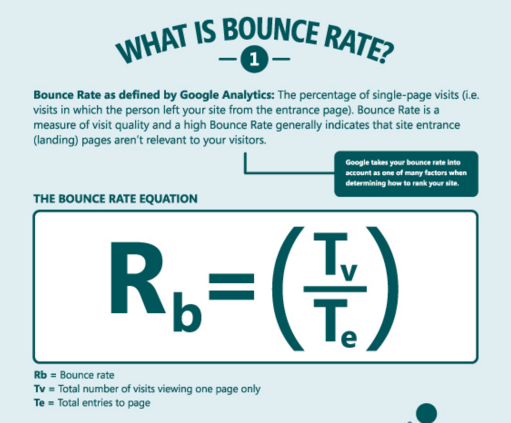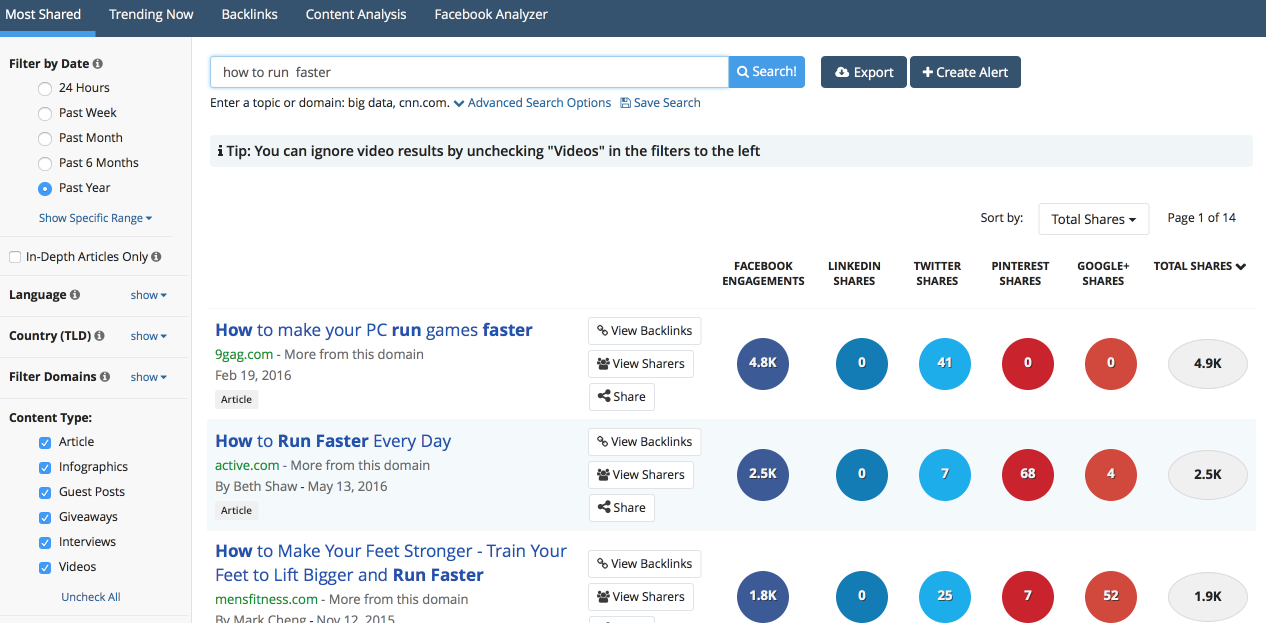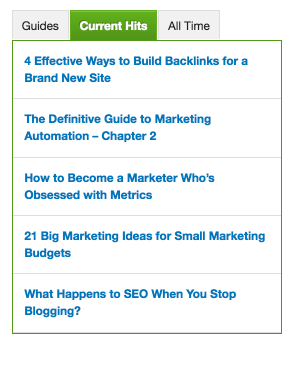Though worth it, creating a successful and engaging blog for your target audience can be hard work.
After all, if you want a blog that’s going to be the envy of your competition and get noticed by the search engines, you’ve got to create an incredible content strategy and do everything that you can to promote the content so that it gets in front the right people.
And, that’s probably what you’re doing right now – hoping that it’s enough to get you the results that you want.
But, how do you know if you’re on the right track when it comes to your media marketing strategy?
What if you think your blog is engaging your target audience – but really, it’s not even close.
How can you verify that your blog is as engaging as it should be and make it so that you’re not misleading yourself?
You check the numbers, you check your key metrics.
Numbers never lie and, if you want to get a truthful assessment in terms of how your blog’s media marketing is performing, you’ll want to check the key metrics behind your blog.
In this post, we’re going to take a look at the key metrics that you need to focus on, if you want to figure out whether or not your blog is engaging your target audience, being shared on social networks, and encouraging a healthy click-through rate.
We’ll also touch on how you can improve these numbers, so that if you find that your key metrics are a little below average, you can easily change things for the better.
By the end of this post, you’ll know of sure-fire ways to check if your blog is engaging or not, as well as what you can do if the latter is the case to improve your own digital marketing strategy.
Let’s begin.
Bounce Rate
Of all the key metrics that we’re going to cover in this post, bounce rate can probably provide you with the most insight – and not just only in terms of how engaging your blog is, but with other factors, too.
In simple terms, bounce rate refer to instances in which someone clicks onto your website and then, clicks the ‘back button.’ Keeping tabs of the click-through rates helps you to understand your target audience, and to see if your media marketing plan is working when it comes to engagement.
If you’re interested, here’s a more detailed description –
Though there’s research to suggest that the average bounce rate is around 45%, your goal should be to get that number as close to 0 as possible.
Why?
If you can keep your bounce rate low, it will mean that people will poke around your blog or web site a
little more, the average time people spend on your web site will improve, and they can check out the other things that you have to offer. They may just find something they want to share on their social networks.
This, of course, is beneficial, because if people read more of your great content, they’re more likely to develop a greater appreciation of just how good your blog is and want to share it on the social networks. At the same time, this also improves your search engine rankings.
Because of this, they’re more likely to opt-in to your subscriber or email marketing list, ensuring that you can later provide them with offers and allowing for you to monetize your blog.The ultimate media marketing plan.
So, what can cause your bounce rate to be high?
For starters, people might reach your blog and then find that the information is not relevant, or good enough and then click the back button to return to the search engine.
So, what does that mean?
Well, it could mean the following…
- People reached your page thinking that they were going to get something else
- They got there and were underwhelmed.
If people were expecting to find something else on your blog or web site, you need to question how these individuals are reaching your site in the first place.
If you’re running paid ads, then you need to take a look at the targeting you have in place. It may be that you’re showing ads to the wrong types of people and you’re unfortunately generating a lot of ‘curiosity clicks.’ This isn’t a good long game for your media marketing success.
Curiosity clicks are obviously bad, because people are clicking on your ads just to see what they’re about, not necessarily because they think there’s any value.
Additionally, you might also want to review the copy that you’re using for your ads. You can get high bounce rates if your ads are targeted properly, but your copy is poor. This is letting you down on your digital marketing plan.
That’s because if you’re promising one thing in your ad copy, but people get another when they’re actually on your blog, visitors will obviously want to click on the back button, as they feel deceived.
Additionally, if you find that your blog produces a high bounce rate, it could be that your content is simply not good enough – that relates to the second reason mentioned.
The best way to see how good your so called great content is, is by taking a look at other content, within your niche, that covers the same topic.
One way that you can do this is by taking a look at the keywords driving organic traffic to the blog post in question and then taking a look at the other content that pops up when that keyword is entered into the search engine.
You’ll be able to find that information within Google Analytics.
You can also use Buzzsumo to identify high performing content that covers the same topic. If you make a side-by-side comparison, you’ll be able to see what’s causing your blog content to fail.
For example, if I were running a blog on ‘running’ and I had a blog post related to ‘running faster,’ I could type ‘How to run faster’ in Buzzsumo and review similar content. I can then build a better content strategy and marketing campaign around these results.
How good is this other content – is it better than what I have. And, if so, why?
Does the other content have more words or images? Does it have some kind of custom formatting?
What can I learn from this content, in order to make my content better? How can I get my content shared on the social networks? How can I use my great content to get more recognition from the search engines?
Another reason people might not click around on your blog is because they’re not simply made aware of the fact that they can do so or are not influenced to do so.
Consider adding more internal links to other content on your site. You might even want to have a sidebar on your site that links to some of your most popular content.
I’ve done this on Quicksprout.
Ultimately, if you want to improve your bounce rates, you need to put yourself in the shoes of your blog visitor and question what it is that’s causing them to not click around on your site and share on their social networks.
Only then can you appreciate why someone might hit your site and then leave right away.
Conversion Rates
Another way that you can identify if your blog is engaging is by taking a look at your conversion rate.
Odds are that you have ways in which people can opt into your email marketing list, on your blog. If you don’t, maybe it’s time to make some changes.
Assuming you do, however, it can be a good idea to check the conversion rates for each of these ‘opportunities’ to opt in.
If you find that your conversion rates are low, it can be a sign that your blog, and more specifically your content, is not engaging your target audience.
This is why.
Let’s assume that you’ve just visited a blog that you didn’t know about, until this present moment.
You spend some time reading the content and find yourself absorbed by what you’re reading – because it’s so good.
When you reach the end of the content, you notice that there’s an opt-in box that informs you that you can subscribe, in order to receive updates on any new content.
Do you think that you’re going to provide your email, so that you can get more awesome content in the future. You bet.
Now, that’s one way of looking at it, of course.
Some people offer a ‘lead magnet,’ in order to get people to join their list.
You should recognize that this ‘lead magnet’ is part of the content on your blog.
Therefore, if you find that your conversion rates are low, it could be that your lead magnet is not engaging enough, too.
So, what can you do to fix that?
I’ve covered here, how you can improve the quality of your lead magnet.
Essentially, your guiding principle should be to make something so good, that it rivals what people would normally pay for.
Yes, it will take a lot of effort and yes, it will take a lot of time.
But, it’s an investment and the energy that you put into creating an incredible lead magnet will pay dividends, over time.
Aside from making your lead magnet better – you might even want to change your approach, so that the way you’re presenting your ‘lead magnet’ is completely different.
That means that you might want to consider the use of ‘content upgrades,’ rather than a standard opt in form.
content upgrades, are highly relevant ‘lead magnets,’ related to the content that a user is engaging with at the time.
Brian Dean raised conversion rates by 785% by using Content Upgrades.
Because they’re so relevant, users are more inclined to engage with them and enter their email, so that they can get what is offered.
Here’s an example of a content upgrade, from Quicksprout.
Just a like a normal lead magnet, if your content upgrade is so good that people would consider paying for it, your conversion rates will be higher than the average conversion rates for content upgrades.
So, if you’ve composed a social network post on Facebook Ads, you might want to create a Facebook Ads Video Walk-through that is a couple of hours long.
People would normally pay for this kind of content, but, if you’re giving it away for free – especially after they’ve just read a social network post on Facebook Ads, conversion rates will be above average. This is an awesome development for your social media marketing.
Note: content upgrades are also effective, because later on down the line, you can more easily segment people, making it easier to send relevant offers to the right people. This has the potential to increase sales as part of your digital marketing plan.
Content shares
The extent to which your content is shared also lets you know how engaging your blog is.
It’s worth noting that content shares are more directly related to the content of your blog, rather than the overall user experience.
The reason content shares are so significant, however, is that content is pretty much the reason people are on your blog in the first place and often why they’ll come back.
So, content shares on social networks show you how engaging your content is.
Plus, people will only share content on their social networks, if they’re confident that it is going to make them look good.
68% of people share content to give others a better sense of who they, themselves are and what they care about.
If a lot of people are sharing your content, it means that they’re indirectly endorsing you, meaning that your content is good and that they have confidence in your blog.
Note: If you’re running a new blog, you’ll need to do some promotion, in order to get people to share your content.
And, the best way to get shares for your content is by emailing people who’ve shared similar content before or by using paid ads.
Note: You can find such people, by taking a look at the ‘View Sharers’ section in Buzzsumo, after having searched for content that’s similar to yours.
It helps to pay attention to how much sharing is taking place, in relation to how much promotion you’re doing. By doing this you will have a clearer view of your social media marketing success.
If you’re sending links of your content to people who’ve shared similar content before, but have yet to see any reciprocation, in terms of shares, it could be a signal that your content or media marketing isn’t engaging.
On top of that, if you’re sending paid traffic to your site, but you’re not generating any shares, again, it could signify that your content and subsequently your blog, isn’t engaging.
If your shares are low when conducting paid traffic campaigns, consider looking at your targeting, and questioning whether you can make it more precise.
Additionally, you’ll also want to keep an eye on how many shares your content is generating, when it is posted on your own social media accounts – say your Facebook Page or your Twitter profile. Again, this delivers great insight into whether your social media marketing strategy is on point.
If you want to learn more about promoting a blog post, I’ve covered the topic here.
Comments
Blog comments are another good indicator of how engaging your blog is.
If, after reading your content, people are blown away, there’s a good chance that they’ll leave you a comment to let you know.
Don’t believe me?
Check out some of your favorite blogs.
In general, you’ll find that the ‘best’ (and hence most engaging) posts on these blogs, tend to generate the most comments.
Though you can take some steps, here and there, to encourage more people to comment, nothing does the trick quite like a great blog post.
In any case, if you want to encourage comments, consider replying to each and every comment that is posted on your blog. Let people know that you’re listening and that you’re appreciative of any engagement.
You might even want to experiment with asking people to leave a comment and suggesting some rules for commenting, too.
Here’s an example, from the Fourhourworkweek blog.
Doing so, will make people feel more comfortable will the idea of leaving a comment, when they otherwise might not have.
Viewing metrics in relation to one another
It’s important to quickly cover this point…
Though each of the metrics we’ve covered here are important, it’s often a bad idea to view them in isolation.
For example, if you’re looking to raise your conversion rates, don’t do so at the expense of your blog’s user experience. That can limit shares and potentially raise bounce rates.
The good news is that if you place a focus on improving the quality of your content, all of these metrics tend to rise as a result.
A rising tide lifts all boats – and your content should be that tide.
Conclusion
By paying attention to the right key metrics, you can improve the levels of engagement on your blog.
Knowing which metrics to pay attention to will let you know exactly what changes need to be made.
For example, a high bounce rate on a blog is letting you know something that low conversion rates don’t.
As mentioned, however, you don’t want to view any of these metrics in isolation.
If you take a holistic view, when reviewing the numbers behind your blog, you can more adequately develop a plan that will make your blog more engaging and develop a stronger social media marketing strategy alongside this.
So, review your numbers now and see what kinds of changes you need to make.
Do you have any tips when it comes to reviewing the metrics behind a blog so that it can be made more engaging? Please let me know in the comments below.







Comments (30)